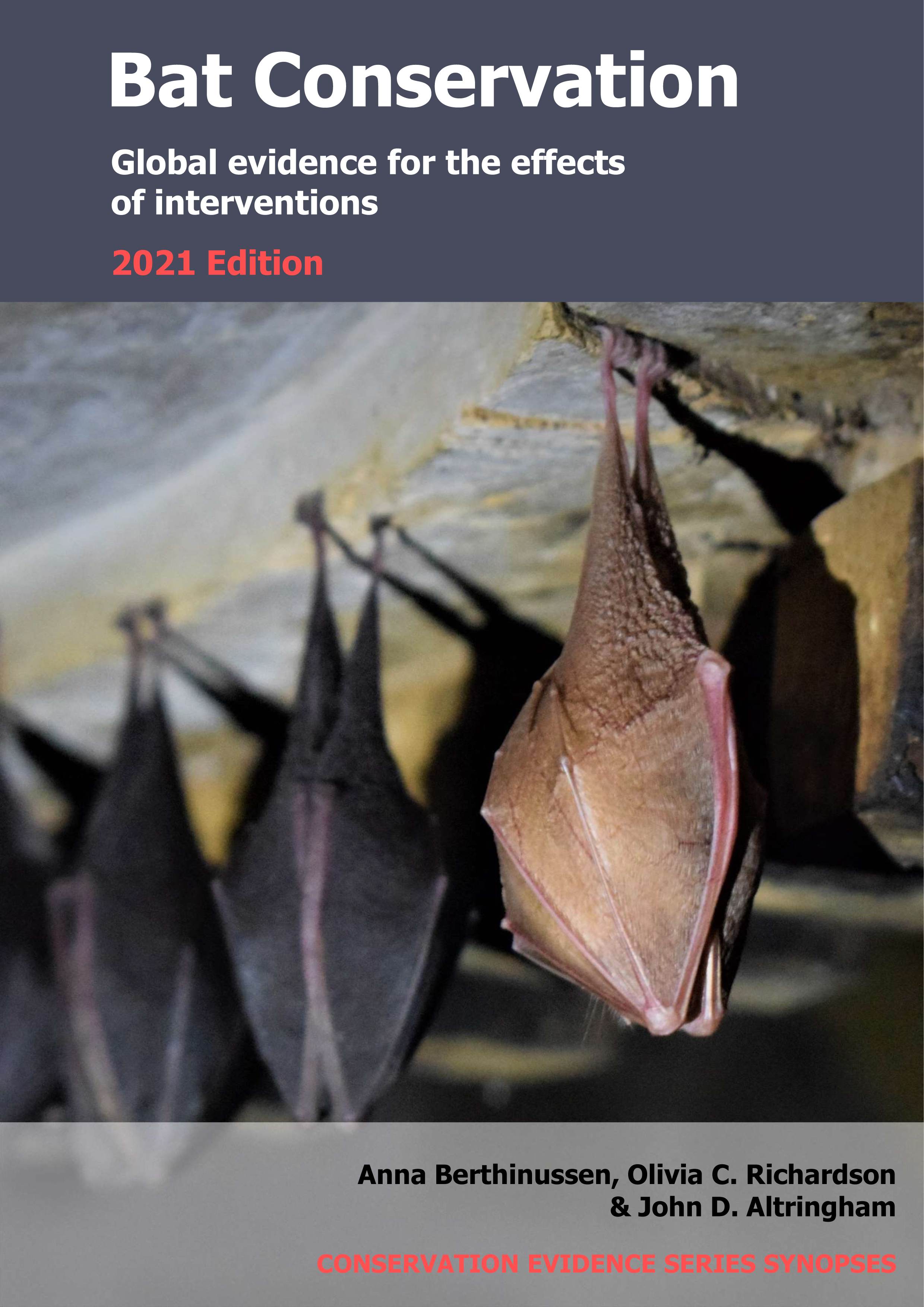Install overpasses as road/railway crossing structures for bats
-
Overall effectiveness category Likely to be beneficial
-
Number of studies: 4
View assessment score
Hide assessment score
How is the evidence assessed?
-
Effectiveness
50% -
Certainty
46% -
Harms
0%
Study locations
Supporting evidence from individual studies
A replicated, site comparison study in 2008 at six overpasses over a road in agricultural and woodland habitat in southern Ireland (Abbott et al 2012) found that three bat species or species groups flew over overpasses but 39–75% of activity was recorded over the road below them, and lower activity was recorded on overpasses than in adjacent habitats. Overpasses were used by three bat species or species groups (common pipistrelle Pipistrellus pipistrellus, soprano pipistrelle Pipistrellus pygmaeus, Myotis spp.), but 39% of common pipistrelle passes, 49% of soprano pipistrelle passes, and 75% of Myotis spp. passes were recorded over the road below overpasses. Bat activity was lower (by >10%) on overpasses than in adjacent habitats (data reported as statistical measures). The overpasses (8–11 m wide x 6–11 m high x 58–76 m long) had minor roads over them. The motorway (65–70 m wide) had four lanes carrying an average of 20,000 vehicles/day. Bat detectors recorded bat activity above and below each of the six overpasses and simultaneously at two adjacent linear features on two nights in May–September 2008.
Study and other actions testedA study in 2013 at two overpasses over two roads in the UK (Berthinussen & Altringham 2015) found that an ‘environmental’ bridge was used by almost two-thirds of crossing bats, but an unvegetated overpass carrying a paved road was not used by crossing bats and only three bats crossed the road nearby. A greater number of bats used an ‘environmental’ bridge (62%, 118 of 192 bats) than crossed the road below at traffic height (19%, 36 of 192 bats). Six bat species or species groups were recorded in total (see original report for data for individual species). An unvegetated overpass was not used by crossing bats and only three bats were observed crossing the road nearby (12–20 m away) at heights of 2–20 m. Both overpasses were designed as crossing structures for bats, alongside other purposes. The ‘environmental’ bridge (30 m long x 5 m wide x 6 m high) had solid vertical sides (2 m high) and was covered with deadwood and planters of hawthorn Crataegus monogyna. The overpass (40 m long x 15 m wide x 8 m high) had a paved road over it and no vegetation. It was designed to carry traffic and provide a crossing structure for bats. Observations of crossing bats and recordings of bat calls were made during 6 x 60-minute surveys at dusk or dawn at each overpass and the road below in June–August 2013.
Study and other actions testedA site comparison study in 2014–2015 of one vegetated overpass over a road within a forest reserve in Brisbane, Australia (McGregor et al 2017) found that the overpass had higher bat activity but the same number of bat species as adjoining forest and bushland. More bat passes were recorded on the overpass (average 52 bat passes) than in the adjoining forest (27 bat passes) or bushland (29 bat passes), although no statistical tests were carried out. Nine bat species were recorded on the overpass and in the adjoining forest and bushland (see original paper for data for individual species). The overpass was hourglass shaped (70 m long x 15 m wide at the midpoint and 20 m wide at the ends) and was planted with natural vegetation and mature saplings (70 shrubs and six trees/100 m2). It was built over two dual lanes of a major urban road bisecting forest and bushland. Bat activity was recorded using bat detectors over two consecutive nights/month between December 2014 and July 2015 at two stationary points on the overpass and along eight 75 m transects perpendicular to the road.
Study and other actions testedA replicated study in 2016 of two overpasses over a road near Lyon, France (Claireau et al 2019) found that both ‘U-shaped’ metal overpasses were used by two bat species or species groups, although 51–65% of bats crossed the road at other locations. One overpass, installed within a bat commuting corridor, was used by 39% (26 of 67) of crossing bats, whereas 51% (34 of 67) crossed the road at other locations within the corridor. The other overpass, installed 325 m from a bat commuting corridor, was used by 19% (7 of 37) of crossing bats, whereas 65% (24 of 37) crossed the road within the original commuting corridor. Crossing heights were not reported. Two bat species/species groups (all Pipistrellus spp.) used the overpasses and 4–6 bat species/species groups crossed at other locations (see original paper for details). Both overpasses (40 m long x 4.8 m wide, <10 m high) were installed (2.5 km apart) over a new four-lane highway in November 2012. At each site, six pairs of bat detectors on opposite sides of the road (one pair at the overpass, five pairs within the commuting corridor or adjacent habitats) simultaneously recorded crossing bats over five consecutive nights in July or September 2016.
Study and other actions tested
Where has this evidence come from?
List of journals searched by synopsis
All the journals searched for all synopses
This Action forms part of the Action Synopsis:
Bat Conservation
Bat Conservation - Published 2021
Update 2020





)_2023.JPG)














